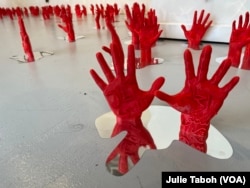September 16 marks one year since Mahsa Amini died in the custody of Iran’s “morality” police. The 22-year-old Kurd was detained for allegedly violating the country’s Islamic dress code requiring that she cover her hair.
Amini’s death sparked months of nationwide protests.
Last November, Iranian officials acknowledged that more than 300 people died in those demonstrations. But human rights organizations say the death toll was much higher.
The Norway-based Iran Human Rights group and the U.S.-based Human Rights Activists News Agency issued a report in January that put the number of dead at more than 500.
Amnesty International says “thousands of people were arbitrarily detained and/or unfairly prosecuted solely for peacefully exercising their human rights.”
Those protests were the inspiration for Persian artist Kiana Honarmand’s exhibition “A Shadow in the Depth of Light,” which was showing at the VisArts Gallery in Rockville, Maryland.
“Just watching the violence was absolutely devastating to see so many people, including men, women, children, getting killed, and thousands arrested,” she told VOA.
Rising hands
Nearly 300 3D-printed hands made from red plastic polymer appear to rise from the gallery floor, each bearing the name of people killed in the protests.
“Each hand represents a human being who has sacrificed everything for the cause of justice, and for women's rights, for human rights,” Honarmand said.
The installation, which has now closed, included long locks of synthetic hair, representing Iranian women who started cutting off their hair in protest of Amini’s death, which caught on with women around the world who began cutting their hair in solidarity.
The popular protest slogan “Woman, Life, Freedom” is printed in Persian across the exhibit’s windows.
“I just had to talk about this because it's the largest and most significant feminist movement of our time and it's not talked about as much as it needs to be,” Honarmand said.
“My first response seeing this exhibition was that the hands coming from the ground looked like a scene from a horror movie,” said Gabriel Soto, visitor services coordinator at the VisArts gallery. “It really reminded me of the living dead coming from the ground.”
“It's a very horrifying thing to imagine that these hands represent people that have been murdered by the state of Iran for [supporting] women’s rights.”
Soto also says the exhibition served as a “wakeup call” to keep the media spotlight on the protests and the response from the Iranian state, “to make sure that people understand that this is still going on, the morality police are still operating, and women are still being brutalized in Iran.”
“What resonated for me here was seeing the ‘bloody’ hands and how much blood there is for Iranian women in their struggle for freedom,” said visitor Andrea Barron.
An advocacy and outreach program manager at the U-S based nonprofit group Torture Abolition and Survivors Support Coalition, which works to end the practice of torture internationally, Barron says she was especially moved by the long strands of hair.
“That was such an important symbol in the recent protests of the women against the morality police after Mahsa was killed,” she said. “Even though these Iranian women are not in the news anymore, I think we need to keep thinking about them and their struggle for freedom.”
Simple acts of disobedience
Honarmand says it’s more important than ever to stand up for women's rights everywhere, “including Iran, Afghanistan, in South America.”
“It's been absolutely inspiring to watch what women in Iran are doing even now, every day, with the simple acts of disobedience, such as just going outside not wearing their compulsory hijabs. … They are very courageous, and I am just in awe of that.”
Going forward, Honarmand says she wants to keep making hands for every confirmed death of an Iranian protester.











